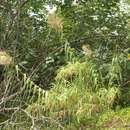Comments
provided by eFloras
This is a very common tall reed familiar to the local peoples for its beautiful inflorescence in the autumn and economic importance; it grows abundantly on the plains and is cultivated as a windbeak between the fields, used as hedges, and for ornamental purposes. Cattle feed on this grass in time of need, and it is a good fodder grass.
- license
- cc-by-nc-sa-3.0
- copyright
- Missouri Botanical Garden, 4344 Shaw Boulevard, St. Louis, MO, 63110 USA
Comments
provided by eFloras
The plants are cultivated for hedges and as ornamentals, the rhizomes are used for medicine, the culms are used for papermaking, and the young leaves are used for forage.
- license
- cc-by-nc-sa-3.0
- copyright
- Missouri Botanical Garden, 4344 Shaw Boulevard, St. Louis, MO, 63110 USA
Description
provided by eFloras
Perennials; rhizomes well developed, bamboo-like; nodes~ usually farinose.
Ligules about 2 mm long, rounded, ciliate. Inflorescence a large panicle, 30-50 cm
long, the main axis at least 2/3 as long as the panicle, the branches 10-20 cm long.
Spikelets in pairs, all alike, unequally pedicelled along a slender continuous rachis;
spikelets about 3 mm long; lower glume as long as the spikelet, minutelv 2-toothed,
3-nerved; upper glume slightly smaller than the lower, margins ciliate, hyaline; lower lemma a little shorter than the glumes, hyaline; upper lemma smaller than the sterile lemma, 1-nerved, extending into a delicate bent, flexuous awn; palea minute, hyaline; anther 3, 1-1.3 mm long.
- license
- cc-by-nc-sa-3.0
- copyright
- Missouri Botanical Garden, 4344 Shaw Boulevard, St. Louis, MO, 63110 USA
Description
provided by eFloras
Plant tufted, robust. Culms erect, 1.5–4 m tall, 6–15 mm in diam., unbranched, nodes usually glabrous, or uppermost sometimes bearded. Leaves cauline, congested; leaf sheaths longer than internodes, overlapping, glabrous, pilose at throat; leaf blades linear, flat, tough, 20–85 × 0.5–4 cm, glabrous, midrib prominent, margins scabrid, base rounded, apex acuminate; ligule 1–3 mm, densely pilose on back. Panicle oblong or elliptic, dense, 20–50 cm; axis 25–45 cm. Racemes numerous, 10–30 cm, appressed or ascending, glabrous, scaberulous; rachis internodes puberulous, nodes glabrous; lower pedicel 1–3.5 mm, upper pedicel 2.5–8 mm. Spikelets 2.5–4(–6) mm, awned; callus hairs 4–6 mm, white, spreading, as long as the spikelet; glumes subequal, membranous, golden brown, 2.5–4(–6) mm, margins pilose near apex, veins obscure, apex acuminate; lower lemma lanceolate, hyaline, 3–3.5 mm, veinless, pilose; upper lemma similar to lower, 2–2.5 mm; awn geniculate, 5–6(–10) mm; upper palea a small hyaline scale. Anthers 3, 1–1.5 mm. Caryopsis oblong, ca. 1.5 mm.
- license
- cc-by-nc-sa-3.0
- copyright
- Missouri Botanical Garden, 4344 Shaw Boulevard, St. Louis, MO, 63110 USA
Habitat & Distribution
provided by eFloras
Slopes, valleys, grassy places. Anhui, Fujian, Guangdong, Guangxi, Guizhou, Hainan, Henan, Hubei, Jiangsu, Sichuan, Taiwan, Yunnan, Zhejiang [SE Asia].
- license
- cc-by-nc-sa-3.0
- copyright
- Missouri Botanical Garden, 4344 Shaw Boulevard, St. Louis, MO, 63110 USA
Synonym
provided by eFloras
Saccharum floridulum Labill, Sert. Austro-Caled, 13. pl. 18. 1824.
Miscanthus japonicus Anderss. in Oefv. Sv. Vet. Akad. Forth. Stockh. 12: 166. 1855; Honda, Monogr. 148. 1930.
Miscanthus formosanus A. Camus, Bull. Mus. Hist. Nat. Paris 30: 514. 1924.
- license
- cc-by-nc-sa-3.0
- copyright
- Missouri Botanical Garden, 4344 Shaw Boulevard, St. Louis, MO, 63110 USA
Physical Description
provided by USDA PLANTS text
Perennials, Terrestrial, not aquatic, Rhizomes present, Rhizome short and compact, stems close, Stems nodes swollen or brittle, Stems erect or ascending, Stems caespitose, tufted, or clustered, Stems terete, round in cross section, or polygonal, Stem nodes bearded or hairy, Stem internodes solid or spongy, Stems with inflorescence less than 1 m tall, Stems with inflorescence 1-2 m tall, Stems with inflorescence 2-6 m tall, Stems, culms, or scapes exceeding basal leaves, Leaves mostly cauline, Leaves conspicuously 2-ranked, distichous, Leaves sheathing at base, Leaf sheath mostly open, or loose, Leaf sheath smooth, glabrous, Leaf sheath hairy, hispid or prickly, Leaf sheath hairy at summit, throat, or collar, Leaf sheath and blade differentiated, Leaf blades linear, Leaf blades 2-10 mm wide, Leaf blades 1-2 cm wide, Leaf blades mostly flat, Leaf blades mostly glabrous, Leaf blades more or less hairy, Ligule present, Ligule a fringed, ciliate, or lobed membrane, Inflorescence terminal, Inflorescence an open panicle, openly paniculate, branches spreading, Inflorescence a dense slender spike-like panicle or raceme, branches contracted, Inflorescence solitary, with 1 spike, fascicle, glomerule, head, or cluster per stem or culm, Inflorescence lax, widely spreading, branches drooping, pendulous, Inflorescence a panicle with narrowly racemose or spicate branches, Inflorescence branches more than 10 to numerous, Flowers bisexual, Spikelets pedicellate, Spikelets dorsally compressed or terete, Spikelet less than 3 mm wide, Spikelets with 2 florets, Spikele ts paired at rachis nodes, Spikelets all alike and fertille, Spikelets in paired units, 1 sessile, 1 pedicellate, Pedicellate spikelet well developed, staminate, Spikelets bisexual, Spikelets disarticulating below the glumes, Spikelets conspicuously hairy , Glumes present, empty bracts, Glumes 2 clearly present, Glumes equal or subequal, Glumes equal to or longer than adjacent lemma, Glumes 3 nerved, Glumes 4-7 nerved, Lemmas thin, chartaceous, hyaline, cartilaginous, or membranous, Lemma 3 nerved, Lemma glabrous, Lemma apex dentate, 2-fid, Lemma distinctly awned, more than 2-3 mm, Lemma with 1 awn, Lemma awn less than 1 cm long, Lemma awn 1-2 cm long, Lemma awn from sinus of bifid apex, Lemma awn twisted, spirally coiled at base, like a corkscrew, Lemma awn once geniculate, bent once, Lemma margins thin, lying flat, Lemma straight, Callus or base of lemma evidently hairy, Callus hairs equal to lemma, Callus hairs longer than lemma, Palea present, well developed, Palea membr anous, hyaline, Palea shorter than lemma, Stamens 3, Styles 2-fid, deeply 2-branched, Stigmas 2, Fruit - caryopsis.

